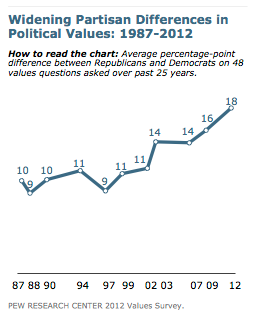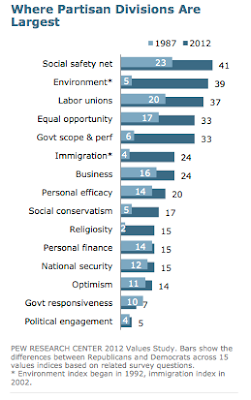In recent years, particularly as both Canada and the United States have entered their respective federal election cycles, it seems to me that I've noticed a dramatic increase in political polarization in both nations. Right hates left and accuses them of being just about everything from neo-Nazis to socialists to libtards among other things and the left returns the favour with other equally creative descriptors that are too numerous to mention. All you have to do is read through the comments section below items in your daily online newspaper edition to see what I mean. I've always wondered if it is just my imagination or if the political sphere really is becoming increasingly polarized along party lines?
The fine folks at the Pew Research Centre recently answered this question for me with their "Trends in American Values; 1987 – 2012: Partisan Polarization Surges in Bush, Obama Years" publication. Over the past 25 years, Pew has asked the same 48 values questions to a randomly selected group of Americans who provide the pollsters with their political party of preference; in the 2012 survey, a total of 3008 adults were asked the same set of questions that Pew has asked on 14 other occasions. The survey covers the public's attitudes on the performance and role of government, national security, labor, business, equal opportunity, the environment and other issues. Please note that the Pew report is extremely detailed and that I will only be covering the basic premise of polarization. If you wish to read more detail about each of the issues covered in the poll, I would ask that you click on the link above to access the entire report.
Let's get to the results of the poll. Here is a summary graph showing the growing partisan gap over the 25 year period as measured by the differences in the responses to the 48 values questions:
Since 2002, the differences in viewpoints on the key issues between Republicans and Democrats has risen from 11 percentage points to 18 percentage points. In the 15 year period prior to 2002, the inter-party differences between those surveyed remained in a constant range of 9 to 11 percentage points; this began to change part way through George Bush II's first term. To ensure that these changes were due solely to political affiliation, Pew has also examined whether the changes in the differences in responses were related to race, education, income level, religion, education or gender and has noted that there was basically no relationship between these factors and the change in the degree of polarization since each factor remained constant over the 25 year period.
Let's take a quick look at where the biggest differences now lie as shown on this bar graph:
The light blue bars show the difference in opinion on each issue as polled in 1987 and the dark blue bars show the change in the difference in 2012. For example, in 1987, the difference between Republican and Democrat respondents regarding support for tougher environmental laws was 5 percentage points; basically, both sides of the spectrum felt the same about the issue. This had risen to 39 percentage points by 2012 with only 47 percent of Republicans supporting tougher laws compared to nearly twice as many Democrats who supported stricter environmental laws. This is one of the most pointed areas of difference between the two sides of the political spectrum.
You'll notice that the difference between the 1987 and 2012 polling results is quite marked for some issues, particularly immigration, support for a government social safety net, labor unions, immigration, religiousity and the scope and performance of government. It is these issues where the divide between Republican and Democrat voters is becoming increasingly polarized.
Overall, over the 25 year period, Republicans have become increasingly convinced that a minimalistic role of government is important and their lack of support for environmental issues has grown markedly as noted above. Among Republicans, conservatives now outnumber moderates by a two-to-one margin. In sharp contrast, Democrats have become more socially liberal and secular in their belief system. Among Democrats, there are roughly equal numbers of those who define themselves as liberal Democrats and those who are moderate Democrats. As well, even though many Americans have given up their specific identity as a member of one party or another, preferring to term themselves "independent", these independents also show increasingly strong leanings toward one viewpoint or another.
While it's all fun and games to play the game that politicians try to lure us into playing, I've always believed one thing; politicians of all stripes do not necessarily have the good of their constituents at heart no matter how hard they may try to convince us otherwise. Go ahead, call me a cynic. Politicians generally choose to vote along partisan lines rather than reflecting the will of those who voted them into office. It's left up to us to stand up for what's right for all voters by holding politicians accountable for the laws that they pass and the decisions that they make. It should not be us pitting ourselves against our fellow voters. This is why buying into the political games that politicians are using to divide and conquer the voting public seems like such a waste of our energy and our time.
The Pew report is fascinating for one reason, it has found a means to quantify the growing political chasm that is dividing the United States, an issue that many of us had suspected all along. Now we know that it's a fact.
Click HERE to read more of Glen Asher's columns
You can publish this article on your website as long as you provide a link back to this page.



Be the first to comment